From the Resene colour choices booklet
Ever thought a house or building would look great painted in a sleek, dark colour – then had to shelve plans for fear of the heat damaging the substrate or the building getting unbearably hot in summer?
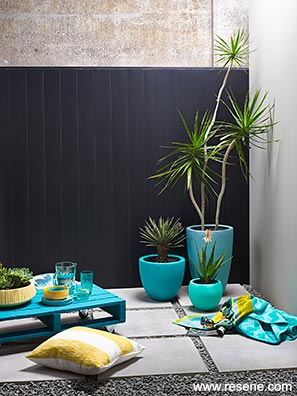
Resene CoolColour technology makes painting exterior surfaces in dark colours both easier and safer. It can be used on all sorts of exterior materials and applications, from weatherboards and concrete to windowsills. A Resene CoolColour looks like a normal colour but thanks to special pigment technology it reflects more heat, so it doesn’t get as a hot as a standard colour would.
When looking at the role paint can play in temperature control in buildings it comes down to colour. The ability of white to reflect visible light extends through the infrared and, because of this, white surfaces remain relatively cool to touch, even in direct sunlight. The opposite is true of black and dark colours, which absorb light in this infra-red area, resulting in significant heat build-up in the surface. As the emissivity of paints is not particularly good, the surface heat is conducted into the substrate and then radiated into the building.
Sunlight energy is made up of 44% visible light, 5% ultra-violet light and 51% infra-red light.
Traditionally light reflectance values have been used to define what colours are suitable for heat prone substrates, however visible light reflectance values only measure a proportion of the light and ignore the effects of ultra-violet and infra-red light. Total Solar Reflectance (TSR) values take into account all three forms of light to give a better measure of the reflectance of the colour. A Resene CoolColour uses pigments that reflect more of the sun’s energy resulting in the same visible light reflectance value as the standard colour but a considerably higher Total Solar Reflectance value.
The solar spectrum includes infra-red radiation that Resene CoolColour pigments are designed to reflect. Replacing the standard black pigment that absorbs all infra-red with a Resene CoolColour black pigment reduces the heat absorption. Some blues, greens and reds are transparent to infra-red radiation so are best used with Resene Quick Dry or Resene Galvo-Prime to reflect infra-red that passes through these hues.
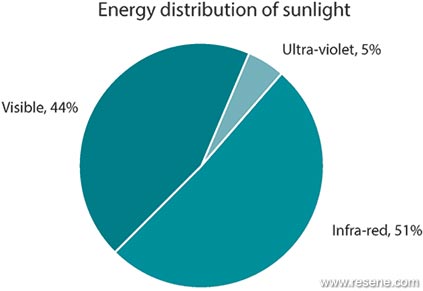
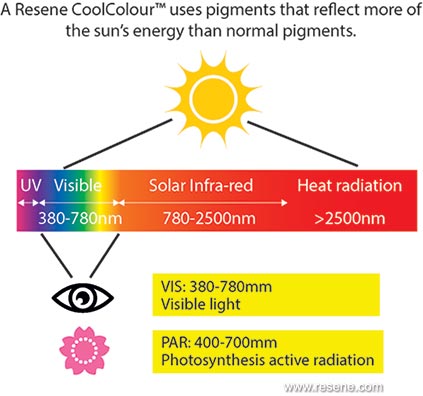
In terms of technology, the Resene CoolColour effect can also be seen in plants. Most plants have leaves of a very high chroma green. If those leaves reached the same temperature when exposed to solar radiation as those of a similarly coloured paint they would shrivel and die. The fact they don’t is because that pigment – chlorophyll – absorbs what it needs from the visible range to photosynthesise but reflects the infra-red range, keeping the plant cool.
Over the past decades, there have been vigorous efforts to create heat resistant pigments in the ceramics industry, as most tints break down at the very high temperatures under which ceramics are fired. Novel ways were discovered of doping refractory metal oxides of titanium, zirconium, chromium, and so on, with other metal ions to produce a wide selection of high temperature colours. The behaviour of these mixed oxides were examined under infra-red and the results showed an ability to withstand a range of very high temperatures. Focusing on this aspect, further refinements were made to maximise this for use in various commercial applications.

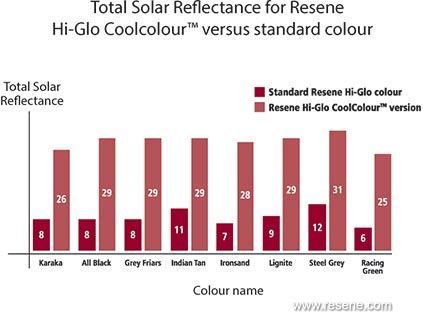
Using these findings Resene took the very popular roofing colour Karaka and incorporated into it these new infra-red reflecting pigments. Comparing the new blend against traditional coatings over a five minute standard Resene test revealed a 12°C drop in temperature. The 12°C difference can make a tremendous difference to the stresses exerted on the substrate and can have a telling effect on its stability and heat gain.
When it comes to roofs, having a darker shade in winter will not make much difference to how hot your roof – and home or building will get – as when it is cold they will be cold too, however in summer it will make a difference as to how hot your home or building will get by reflecting heat away from the building.
First developed for high gloss roof coatings, Resene CoolColour is now available in a range of paints and stains. These include Resene Lumbersider low sheen, Resene Sonyx 101 semi-gloss, Resene Hi-Glo gloss, Resene Summit Roof satin/semi-gloss, Resene Enamacryl gloss waterborne enamel, Resene Super Gloss enamel, Resene Lustacryl semigloss waterborne enamel, Resene SpaceCote Flat waterborne enamel, Resene X-200 waterproofing membrane, Resene AquaShield mineral effect, Resene Waterborne Walk-on paving paint, Resene Non-Skid Deck & Path, Resene Waterborne Woodsman wood stain, Resene Woodsman Decking Oil Stain and Resene Woodsman wood oil stain.
Resene CoolColour technology works best in dark shades most prone to heat build-up, including popular colours such as Resene Nero, Resene Karaka and Resene Napa. A wide range of Resene CoolColour hues are now available – see colours marked with a CC on Resene colour charts or view the list online on the Resene website in the Resene colour library. Check with your Resene ColorShop or representative to see if a Resene CoolColour is right for your project.
Although it may be hard to believe, these two colours behave the same in test procedures. The test procedure involves fixing thermocouples onto the backs of these panels (ensuring a good thermal contact); shining an infra-red light onto the painted side of the panels and plotting the temperature rise of the panels on the thermocouples.
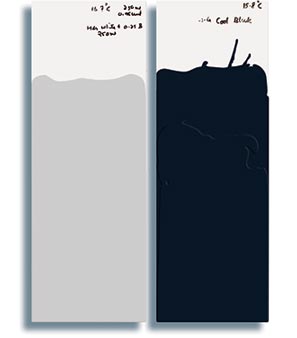
Although it may be hard to believe, these two colours behave the same in test procedures. The test procedure involves fixing thermocouples onto the backs of these panels (ensuring a good thermal contact); shining an infra-red light onto the painted side of the panels and plotting the temperature rise of the panels on the thermocouples.
The grey panel is a standard coating. The black panel uses Resene CoolColour pigments. The black Resene CoolColour panel has the same infra-red (heat) absorption as the standard paint finish on the grey panel, demonstrating the reflective benefits of Resene CoolColour technology.
We all know how it works. You agonise over the colour charts and then settle on the ideal shade. You watch as the Resene ColorShop professional measures the perfect combination of colour into the can and locks it into that frenetic mixing machine, where it shudders itself into the blend you were after.
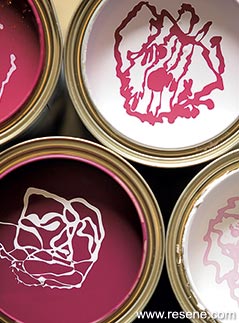
Most Resene paint consists of a tone colour, which is then tinted with measured units of colourants, depending on the final required shade. There are limits to how much tinter you can add to each tone. If you fall under that limit, you can affect the opacity of the paint and make it more difficult to get a good, even finish. If you go over the limit, you can interfere with its film-forming properties and therefore its longevity.
The rule of thumb is that tinters affect paint durability, so the less tinter you use, the longer the colour will last. Colours are formulated to be tinted from certain tones. If you try to tint a colour from a tone it’s not designed for, while you might be able to get the correct shade, chances are you will have over-tinted it and it will fail faster.
So, don’t try getting a dark colour tinted into a white paint – it may save you money today, but it will turn out a false economy when you have to repaint earlier than usual.
Every paint company uses different tinters to make up their colours. To capture the true essence of the colour you like, you really need to buy it tinted into the brand of paint it was developed for. You can also add depth of colour by using tinted undercoats beneath the topcoat, but the same criteria apply.
Paint quality also has a bearing on the tinting issue. High quality paints use more concentrated tinters, so the paint keeps its colour and integrity for longer. Good quality tinters provide good coverage too, so that you only usually need to apply two topcoats to get the shade you want, whereas it may take more coats of a lower grade paint to give you a true colour. High quality paints also tend to have more complex colourways and will change subtly in changing lights.
Certain individual colours also tend to be less durable than others, due to the make-up of their colourants. Bright oranges, yellows and reds still tend to fade faster than other shades. The best colours for longevity are the earthier tones, which are made from oxide tinters.
If you do get offered a significantly cheaper price for the same colour in another brand, beware! Not only will the colour not truly match the original, the paint will almost certainly not last as long and therefore not represent the best value in the long-term. The most expensive part of a paint job, in terms of money and time, is the painting, not the paint itself, so it makes sense to invest in a high quality product at the start, get it tinted properly, and minimise maintenance and repainting further down the track.
▸ Download a PDF of this article
Resene colour choices booklet
Choose colour with confidence and creativity